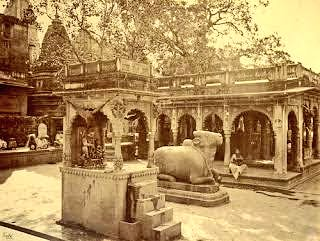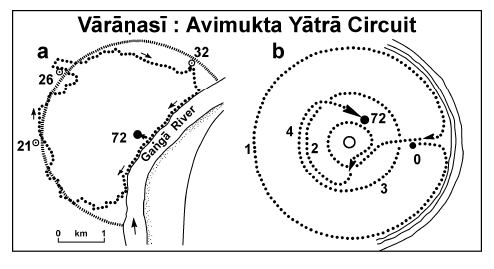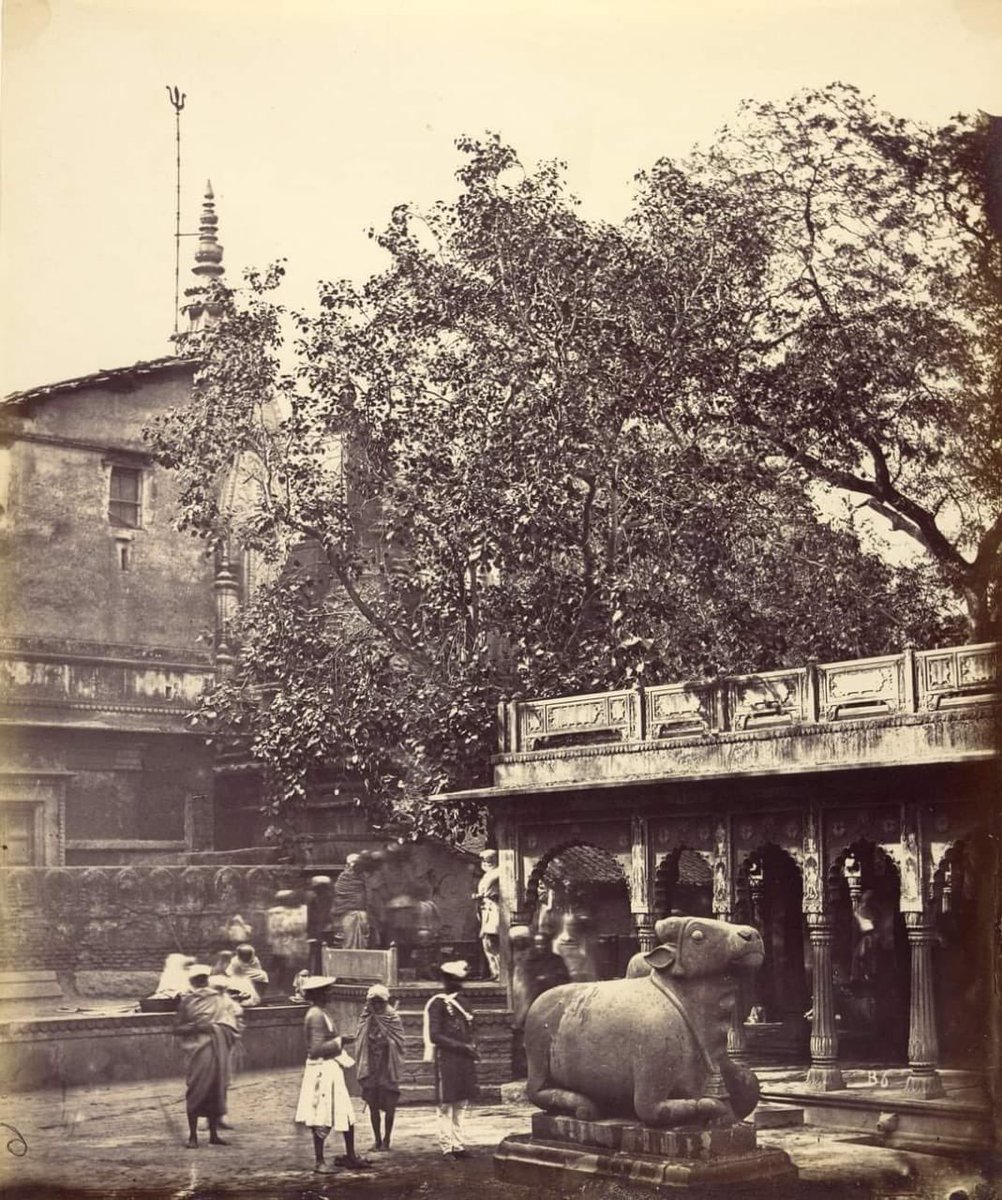
Why is #Kashi so significant to Hindus? Part-3 #Thread
"A Basic Description of the #Kashi Tirtha Yatra"
Even after performing crores of Yajnas one cannot acquire the opulence which one can get at every step while walking in the lanes of Kashi. (Kashi Khanda)
"A Basic Description of the #Kashi Tirtha Yatra"
Even after performing crores of Yajnas one cannot acquire the opulence which one can get at every step while walking in the lanes of Kashi. (Kashi Khanda)

Tirtha "तीर्थ" is a Sanskrit word that means "crossing place, ford", and refers to any place, text or person that is scared. It particularly refers to pilgrimage sites and scared places.
Tirtha originally referred to a fordable river, which was chosen solely for its utility.
Tirtha originally referred to a fordable river, which was chosen solely for its utility.

Hindus build "Axis Mundi," temporary or permanent representations of a substantial part or the entire cosmos, to maintain a harmonious relationship throughout the universe. 



The #Jnanavapi Kupa ('Well of Wisdom') is Varanasi's axis mundi, where Shiva's liquid form dug up the earth with his trident and offered the water to another of his forms, Avimukteshvara (the most ancient form of Shiva in Varanasi).
NOTE: This is not a Fountain.
NOTE: This is not a Fountain.

Shiva swore to take permanent abode in the well and stay there indefinitely. Shiva's alias Ishvara (Ish + chara) refers to his position at the centre of the universe (ish), from which he governs the cosmos' rhythm (chara). 



The shrine of Avimukteshvara lost its identity through time as a result of Muslim monarchs deconstructing temples, and its mystic power was transferred to Vishveshvara/ Vishvanatha (known as Golden Temple in the West). 

Pilgrims and #Jnanavapi Kupa currently perform initiation and completion rites at this location. Varanasi is home to a number of sacred sites that have been classified in various ways. 5 of them are the most popular, according to scriptures.
The 4 inner sacred travel routes converge at #Jnanavapi, the axis mundi, while the outside circle encompasses all else and meets in the west at Dehli Vinayaka. Dehli means "gate" in Sanskrit, and it is here that Ganesha, grants respite from all obstructions as well as wisdom. 



Ganesha/ Vinayaka, with his 56 forms, defends the residents and visitors of this city from difficulties in all seven layers of the world between earth and heaven in eight cardinal directions (symbolically representing seven layers of the atmosphere). 



They serve as lokapala, the universe's directional guardians who live at all cardinal intersections. A spatio-cosmological model depicting the eight directions, seven strata, three sacred segments of Varanasi.
The Forms of 56 Vinayakas.


The Forms of 56 Vinayakas.



The 5 sacred and pilgrimage circuits represent the parallels of 5 heavenly gross elements of Hindu cosmogony, namely sky/ether, earth, air, water, and fire, with 5 basic parts of the human body, namely head, legs, face, blood, and heart... 

and transcendental power and the associated sheath, as well as the corresponding sacred number of shrines on the route. #Jnanavapi, also known as the axis mundi of the cosmos in the mesocosmic sphere, exists beyond of mundane space and time, yet being a visible location on Earth. 

The outermost sacred circuit (Chaurashikroshi Yatra), symbolising the shadow of cosmic light, is defined by a distance of 5 kroshas (equivalent to 11 miles/ 17.6 km) between the temple of Madhyameshvara and Dehli Vinayaka. 

The cosmic realm known as Kashi Mandala is identified by its circumference. There are 12 goddesses (Shaktis) in each of the 8 directions, 1 energy goddess (Durga), one of her male companions (Bhairava), 3 demigods (Vetalas), 1 directional deity (Dikapala). A total of 144 members. 



Cardinality and sacred geometry were initially mentioned in relation to Madhyameshvara as the centre and Dehli Vinayaka as the radial point (Padma Purana); in fact, this was the same as Chaurashikroshi Yatra. 

After some time, literary sources describe #Jnanavapi as the navel-point and pivot for all pilgrimages; this led to the acceptance of Panchakroshi as a better alternative to the outer rout in terms of accessibility, time consumption. 

The cardinal and intercardinal directions are used to describe routes as reference points, but they spin at different rates. This is simply explained by comparing 56 Vinayaka shrines located along the spiral route (7 rounds) following the cardinal bisecting points (8 directions). 

The 2nd circuit (Panchakroshi) is 88.5 KMS long (25 kroshas) and has 108 shrines. This is the most popular pilgrimage trek, which takes only 5 days to complete (four, or five night halts). 

The Nagara Pradakshina, or third sacred circuit, delimits the city boundary according to numerous scirptures. The 25-kilometer path connects 72 important temples and locations. Pilgrims usually finish this journey in two days, stopping at Pashapani Vinayaka. 

The fourth sacred circuit is named after Shiva's zone "Never Forsaken" (Avimukta). Surya (Sun) encouraged Shiva to reside in this place forever, according to a Skanda Purana, hence the name Avimukta. 

The shrine of Avimuktesbvara sits at the centre of this region, from which the circular route proceeds at a radial distance of around 2 kilometres. It does not, however, cross the Ganga. Rather, the path follows the river's left bank. 

Tripurantakeshvara (no. 21), Valmikeshvara (no. 27), and Omkareshvara (no. 28) are the three shrines that serve as reference points on the raised mound, from south to north (no. 32). 

The three edges of Shiva's trident are likewise represented by these three mound sanctuaries (Trishula). The processional route from no. 52 (Maheshvara) to Avimukteshvara follows a complex spiral pattern, turning four times. 

The 5th, the inner sanctum sanctorum (Antargrha), circles the temple of Vishveshvara 7 times. It represents cosmic harmony, with 7 chakras (spinal energy zones, or plexuses) and eight cardinal directions. This is how Shiva defends his domain, much like Kashi defends his own body. 

At all times, I want all Hindus to be well-informed on the truths of #SanatanaDharma. Share and RT with your followers.
Stay tuned for Part 4. ..👇
For those who missed
Part 1
threadreaderapp.com/thread/1528733…
Part 2
threadreaderapp.com/thread/1529318…
Stay tuned for Part 4. ..👇
For those who missed
Part 1
threadreaderapp.com/thread/1528733…
Part 2
threadreaderapp.com/thread/1529318…
@GSNarayan1960
@DrUgrabhatah
@AjitsinhJagirda
@Anandi_sanatani
@neerangautam
@chimnibai
@_ankahi
@SoniaGurnani19
@ArunDeshpande20
@nrajabpcl
@SortedEagle
@VeerannaAthani
@bs_hariharan3
@SanskarBarot
@RocksMagik
@keeranl
@LoveBharatvarsh
@DrUgrabhatah
@AjitsinhJagirda
@Anandi_sanatani
@neerangautam
@chimnibai
@_ankahi
@SoniaGurnani19
@ArunDeshpande20
@nrajabpcl
@SortedEagle
@VeerannaAthani
@bs_hariharan3
@SanskarBarot
@RocksMagik
@keeranl
@LoveBharatvarsh
@threadreaderapp unroll
• • •
Missing some Tweet in this thread? You can try to
force a refresh














